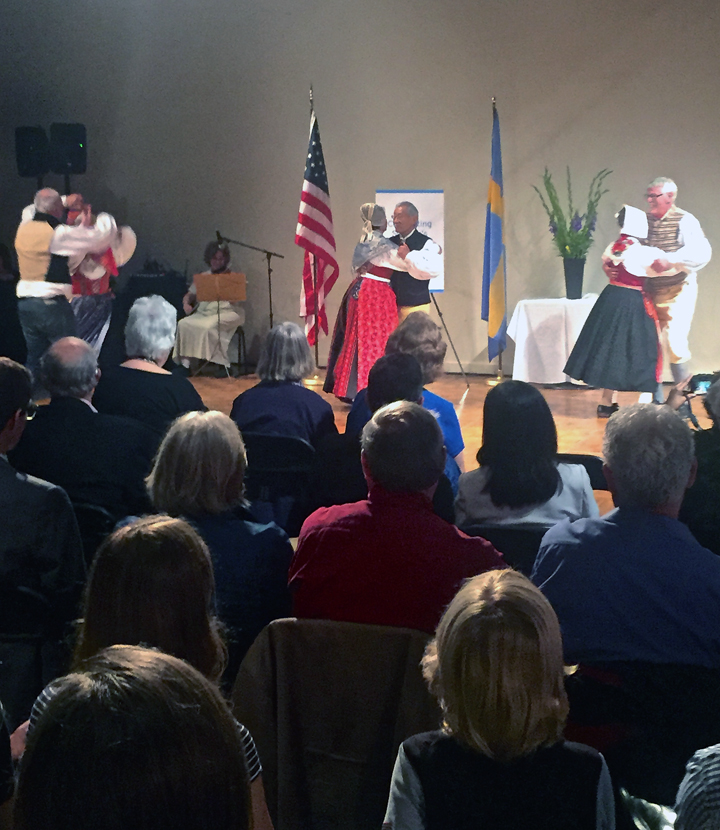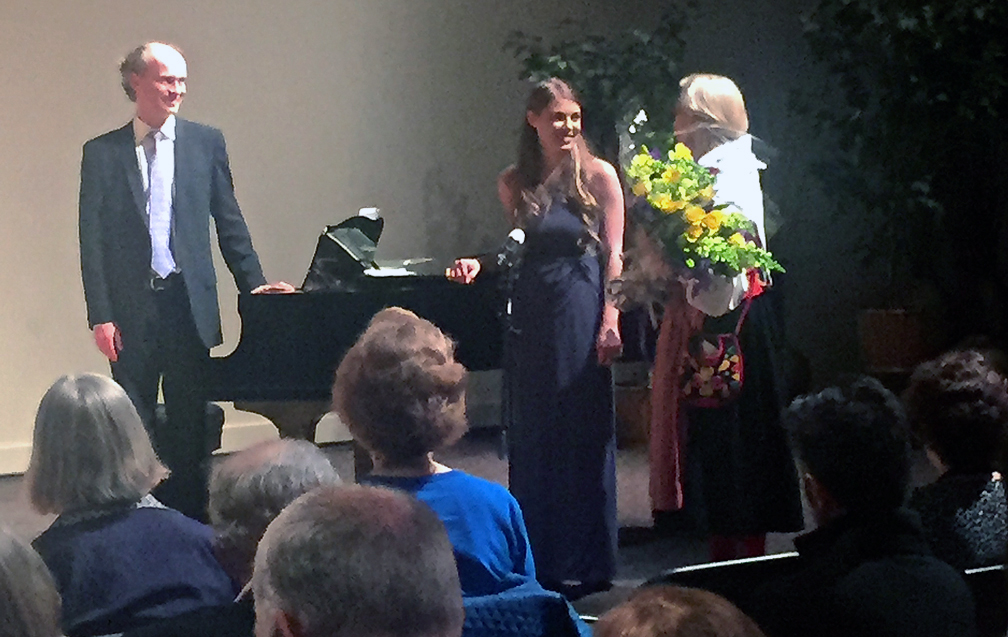Sweden Day at Palace of Fine Arts
A return to the world's fair iconic site and a very special occasion sold out quickly. Everyone present felt privileged and thankful to attend the beautiful program on Sweden's National Day at the Palace of Fine Arts in San Francisco.
-
 The folk dancers whirled through traditional Swedish folk dances. Photo by Ted Olsson
The folk dancers whirled through traditional Swedish folk dances. Photo by Ted Olsson -
-
On Saturday evening, June 6, 2015 Swedish Consul General Barbro Osher invited Swedes and Swedish Americans to celebrate Sweden’s National Day at the Palace of Fine Arts, where Sweden’s exceptional fine arts had been exhibited a century earlier. It was wonderful to return to a small part of the special location, that is otherwise currently devoted to iHangar — a celebration of the 1915 world’s fair’s technologies and creativity with incentives for young visitors to tinker and develop their own ideas with today’s technologies and techniques. Like other events of the year, this one celebrated Sweden’s role at the fair by not merely acknowledging Sweden then, but also Sweden now and tomorrow.
Consul General Osher welcomed all and described the significance of the day. On June 6, 1523, Gustav Eriksson of the Swedish noble Vasa family, was elected king of the newly independent Swedish nation, following its victory in the Swedish War of Liberation against King Christian II of Denmark, ending the 126-year Kalmar Union of Denmark, Norway, Pomerania and Sweden, ruled by Danish monarchs. Eleven days later, Vasa’s rebel forces entered Sweden’s capitol, and on Midsummer the new king entered Stockholm triumphant as Gustav Vasa. With his coronation in 1528, the monarchy changed from an elected one to an hereditary one. The new king centralized power and authority with royal appointments of governors and bishops, thereby breaking with the Catholic Church and establishing the Lutheran Church of Sweden — making it perfectly apt for Consul General Osher and Deacon Åsa Sjöberg of the Swedish Church in America to sponsor this observance of Sweden’s National Day.
June 6 also marks the date of Sweden’s modern constitution (the Instrument of Government of June 6, 1809 was the successor to Sweden’s first written constitution, the 1634 Instrument of Government). That constitution established the sharing of government authority between the executive monarchy and the legislative Riksdag. While the king could still choose his own councilors then, he had to make all state decisions in the presence of cabinet ministers. Under the subsequent 1974 Instrument of Government, today’s council was gradually transformed into an executive cabinet of ministers chaired by the parliamentary prime minister that governs independent of the ceremonial monarch.
Of course for many of us, June 6 was always celebrated as Sweden’s Flag Day. The consul general mentioned that only in 1983 did the date become Sweden’s official National Day holiday. Gustav Vasa’s establishment of his Kungliga Hovkapellet (Royal Court Orchestra) in 1526 included 12 musicians, making the orchestra of the Royal Swedish Opera now one of the oldest in the world. Thus, it is so appropriate that modern observances of Sweden’s National Day include musical performances.
Consul General Osher welcomed the artists for the concert. Ragnar Bohlin, director of the San Francisco Symphony Chorus, had accompanied the audience for the singing of Sweden’s national anthem and Psalm 200: 1-2. He returned to the stage and introduced Leandra Ramm, a mezzo-soprano who recently moved from New York to join Bohlin's professional chorus. Bohlin introduced their songs from a recent publication of Swedish art songs — they were beautiful and quite moving, Bohlin’s piano complimenting the soloist’s every emotion. But the concert was also interesting for its selection of songs, offering a couple pairings where the same poem was presented in two settings, one each by different Swedish composers.
Osher next introduced a troupe of folk dancers and their violinist of traditional folk melodies. Their hambos and polkas were delightful, and they amused the audience by demonstrating the solution to dancing when there are more people than can be paired. And they even taught us how to update the traditional dances and rhythms with modern dance steps. Everyone was enchanted by their brisk dances and enjoyed speaking with these dancers afterwards.
At the end, Osher invited the audience to enjoy the delicious Swedish refreshments: Princess cake and cinnamon rolls with champagne, saft and water. Everyone enjoyed chatting with friends afterward, and Osher added one further element that linked this occasion to those of a century ago: Among the items decorating the social rooms of Sweden’s Pavilion at the 1915 fair was a set of sixteen 3-feet-tall dolls exquisitely dressed in Swedish provincial costumes. These had been purchased following the fair by Mrs. Phoebe Apperson Hearst and later donated to her museum at the University of California-Berkeley, where they will be featured next year at the reopening of the museum.
For this Sweden Day, the museum showed a video of stills showing each of these magnificent dolls created for this centennial's year-long commemoration of the Panama-Pacific International Exposition, in the idyllic setting of the 1915 Palace of Fine Arts. -
 Consul general Barbro Osher thanks Ramm and Bohlin. Photo by Ted Olsson
Consul general Barbro Osher thanks Ramm and Bohlin. Photo by Ted Olsson -
-
~ TED OLSSON
San Francisco -
-
